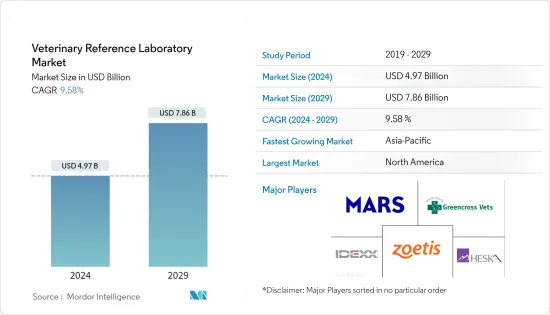PUBLISHER: Mordor Intelligence | PRODUCT CODE: 1445722

PUBLISHER: Mordor Intelligence | PRODUCT CODE: 1445722
Veterinary Reference Laboratory - Market Share Analysis, Industry Trends & Statistics, Growth Forecasts (2024 - 2029)
The Veterinary Reference Laboratory Market size is estimated at USD 4.97 billion in 2024, and is expected to reach USD 7.86 billion by 2029, growing at a CAGR of 9.58% during the forecast period (2024-2029).

The COVID-19 pandemic disrupted the R&D activities of veterinary diseases and the logistics supply of various essential pharmaceutical products for pets. For instance, according to an article published by Frontiers in May 2022, in the United Kingdom, a dog's chronic illness diagnosis, including cancer, reduced the odds of seeking care during the pandemic, reportedly due to difficulties in accessing care for non-urgent issues and lack of access to veterinarians. However, with the declining COVID-19 cases and ease of restrictions, the studied market is expected to regain its full potential over the years.
The major factors driving the growth of the market are the increase in companion animal/pet adoption, the increasing demand for pet insurance, the growing animal healthcare expenditure, and the growing demand for PCR testing, rapid testing, and other testing procedures.
The rising adoption of companion animals is a major factor driving the market's growth. For instance, according to the data published by the European Pet Food Industry: Facts and Figures 2022 report, Germany had 10,300,000 dogs and 16,700,000 cats in 2021. As per the same source, the percentage of German households owning at least one cat was 21%, and one dog was 19% in 2021. This shows that the adoption of cats was higher among the population than dogs.
Additionally, as per the Pet Food Manufacturer's Association (PFMA)'s Pet Population 2022 data published in 2022, 34.9 million pets were estimated in the United Kingdom in 2022 (13 million dogs and 12 million cats). Similarly, according to the data published by the European Pet Food Industry: Facts and Figures 2021 in 2022, 12,000,000 dogs and 12,000,000 cats were reported in the United Kingdom in 2021. As per the same source, the estimated percentage of UK households owning at least one cat was 33%, and one dog was 27% in 2021. Thus, the increasing adoption of pets is expected to increase the demand for veterinary reference laboratories.
The developments by key market players are expected to increase the market's growth. For instance, in September 2021, Heska Corporation acquired majority ownership of Biotech Laboratories USA LLC, a leading developer of rapid assay diagnostics testing.
Thus, factors such as the rising pet adoption and the increasing developments by key market players are expected to boost the market's growth. However, rising demand for portable devices for point-of-care (POC) services and high pet care costs are expected to hinder this growth.
Veterinary Reference Laboratory Market Trends
Companion Animal Segment is Expected to Hold a Significant Market Share Over the Forecast Period
The companion animal segment is expected to hold a major share of the veterinary reference laboratory market due to the high prevalence of chronic and infectious diseases in companion animals, growing pet adoption, and increasing life expectancy, further increasing the risk of diseases. For instance, according to an article published by Frontiers in March 2021, cancer is considered the leading cause of death in dogs, partly because many cases are identified at an advanced stage when clinical signs have developed and the prognosis is poor. Thus, the rising prevalence of cancer in companion animals is expected to increase the usage of veterinary reference laboratories.
According to the data published by Animal Medicines Australia (AMA) in November 2022, Australia spends over USD 33 billion annually to keep pets healthy, nourished, and well-accessorized. Out of the USD 33 billion spending, 14% is spent on veterinarians and 9% on healthcare products. According to the same source, the annual household spending for veterinarian services and healthcare products for dogs was USD 631 and USD 323, respectively, in Australia in 2022. Similarly, the annual household spending for veterinarian services and healthcare products for cats was USD 388 and USD 280, respectively, in Australia in 2022. Thus, the rising pet care expenditure is also expected to enhance the segment's growth.
According to the data published by the European Pet Food Industry: Facts and Figures 2021 report, 10,300,000 dogs and 16,700,000 cats were reported in Germany in 2021. As per the same source, the percentage of German households owning at least one cat was 21%, and one dog was 19% in 2021. This shows that the adoption of cats was higher among the population than dogs.
According to Der Deutsche Heimtiermarkt data, updated in 2022, 47% of the households in Germany had pets in 2021, including 34.7 million dogs, cats, small animals, and ornamental birds. Also, as per the same source, the number of cats adopted was higher in Germany compared to the adoption of dogs. About 16.7 million cats live in 26% of German households, compared to 10.3 million dogs in 21% of households. Thus, the rising pet adoption is also expected to boost segment growth.
North America is Expected to Have a Significant Market Share Over the Forecast Period
Veterinary Reference Laboratory Industry Overview
Additional Benefits:
TABLE OF CONTENTS
1 INTRODUCTION
- 1.1 Study Assumptions and Market Definition
- 1.2 Scope of the Study
2 RESEARCH METHODOLOGY
3 EXECUTIVE SUMMARY
4 MARKET DYNAMICS
- 4.1 Market Overview
- 4.2 Market Drivers
- 4.2.1 Increase in Companion animal/Pet Adoption
- 4.2.2 Increasing Demand for Pet Insurance
5 MARKET SEGMENTATION (Market Size by Value - USD million)
6 COMPANY PROFILES AND COMPETITIVE LANDSCAPE
7 MARKET OPPORTUNITIES AND FUTURE TRENDS




